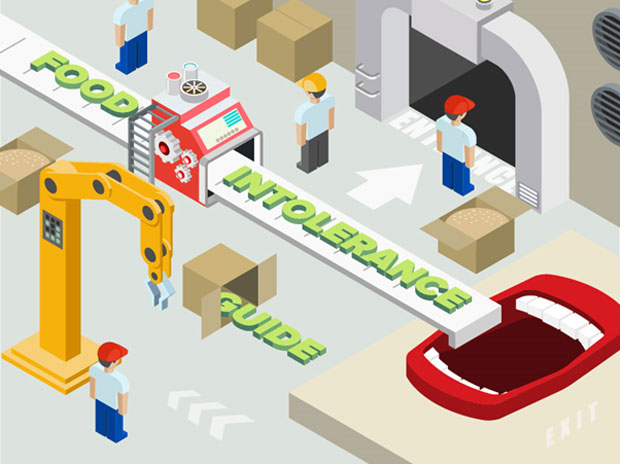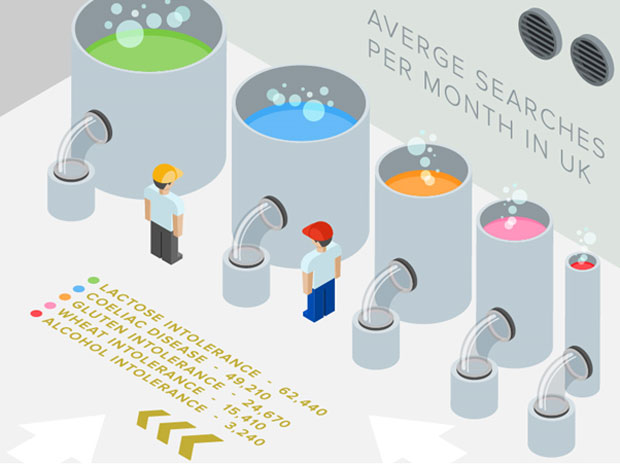A Food Intolerance Guide

A Food Intolerance Guide
A food intolerance is when someone develops symptoms after eating certain foods, often in larger quantities. It’s not the same as a food allergy which is a rapid and potentially very serious response to a food by your immune system and can result in rashes, wheezing and itching. 1-2 out of every 100 people in the UK have a food allergy.
Food intolerances can have similar symptoms but your body does not produce antibodies against the food, like it does when you are allergic. 1 in 5 people in Britain believe that they have an intolerance, but these are often self-diagnosed.
The symptoms of food intolerances often develop more slowly, even after many hours after eating the problem food which makes it very difficult to know which exact food is causing the problem. There are also many other digestive conditions (such as inflammatory bowel disease, gastrointestinal obstructions or Irritable Bowel Syndrome) that can be mistaken for a food intolerance.
Causes Of Food Intolerance
There are many different causes of food intolerance, some can be:
- Additives in processed foods. Both natural and artificial colourants and preservatives can be something that people are hypersensitive to.
- Enzyme defects in your body. If you’re lacking enzymes needed to break down natural substances in certain foods you can get a variety of symptoms.
- Toxic effects can be caused by foods that naturally contain certain substances. That’s why you have to cook some foods properly before you can eat them. Then the toxins disappear.
- Pharmacological. Naturally occurring chemicals are sometimes present in foods and can have an effect on some people while others don’t notice anything.
- Salicylates in foods. These are present in many foods eaten by many people but most of us will not have any symptoms. Some people will experience problems if they eat too much of foods that contain them.
- Histamines in foods. These are naturally occurring in some foods and can also be developed in foods that are not stored correctly. For some people, these can give symptoms.

The Most Common Food Intolerances in the UK
- Lactose Intolerance – Avg. searches per month in UK (62,440)
The cause is due to an inability to digest lactose (a sugar present in milk) due to having an absence or really low levels of the enzyme lactase which is responsible for digesting lactose. Common symptoms include diarrhoea, bloating and general discomfort.
- Gluten Intolerance – Avg. searches per month in UK (24,670)
Gluten intolerance (also referred to as ‘non-coeliac gluten sensitivity’) is when you get symptoms after eating foods containing gluten, like wheat, barley and rye. The symptoms are similar to coeliac disease but the difference is that an intolerance does not cause damage to the lining of the gut. Coeliac disease is much more serious.
- Wheat Intolerance – Avg. searches per month in UK (15,410)
Wheat intolerance has similar symptoms to coeliac disease, including abdominal discomfort, nausea, tiredness, bloating and altered bowel habit, but is different in many ways. When you are intolerant to wheat you will still experience adverse effects from gluten free products because you are intolerant to all parts of the wheat not just the gluten.
- Alcohol Intolerance – Avg. searches per month in UK (3,240)
Many people experience symptoms as a result of being intolerant to alcohol but it’s really difficult to know exactly what is the cause. It can be a lack of enzyme in your body, a reaction from the mix of food and alcohol, one particular brand of drink or all alcoholic drinks, grapes or grains used to produce the alcoholic drink or even substances such as histamines, sulphites, yeasts or other additives that are present in some drinks. The best way to identify the cause is to keep a diary of the drinks you consume and the symptoms you experience.

Symptoms
The symptoms caused by food intolerances are very varied and complex and range from relatively general symptoms like headaches and migraines, stuffy or runny nose, low mood, night sweats, lethargy and aching joints to skin symptoms, including rashes and eczema, as well as gastrointestinal symptoms, such as vomiting, diarrhoea, bloating and irritable bowels.

Identification, Diagnosis & Treatment
Other than tests for coeliac disease and lactose intolerance, there aren’t any reliable ways to test for food intolerance. The way you do it is by doing diagnostic diets, exclusion diets, to try to find the cause of your symptoms. You eliminate possible trigger foods and gradually reintroduce them to spot the reasons for your problems. This process requires a lot of planning and dedication but the results can be life changing so it’s worth trying.

This post is my own summary of a guide put together by Vital Footprint. All words are my own. The illustrations are from the original guide. Visit Eat Joy and subscribe via email to receive exclusive recipes for gluten and dairy intolerances and vegan diets.
Are you intolerant to any foods?




